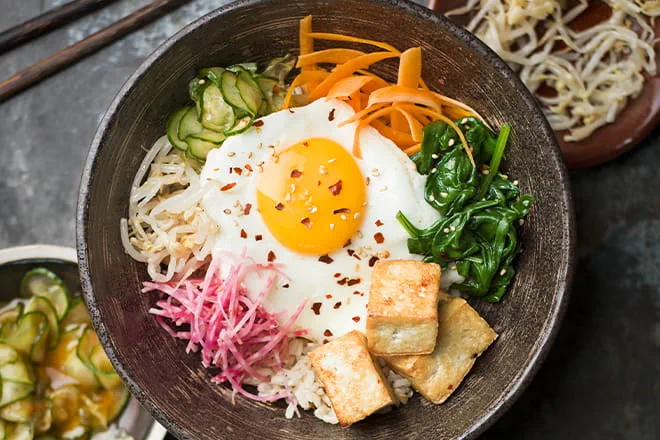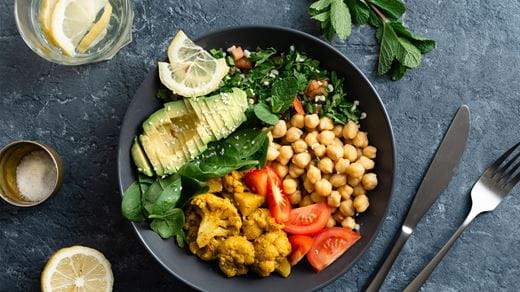Written by: Rowena Leung, RD
Start the New Year in a fun and healthy way by opting for plant-based alternatives in traditional dishes from around the world.
With the palates of Canadians continuing to become more diverse, more and more people are interested in incorporating ingredients and/or dishes from other cultures into their eating habits. At the same time, individuals are taking heed to incorporate plant-based nutritional elements into their daily diet, taking advantage of the benefits of cutting back on meat and dairy ingredients.
What better way to kick off the New Year than by combining both!

Can a traditional meat- or dairy-based ethnic dish be made vegetarian and/or vegan? We are here to show you how! Keep in mind that plant-based eating doesn’t have to mean excluding all animal products. The intent of plant-based eating is to help an individual incorporate more foods such as fruits and vegetables, legumes, plant oils, and nuts without necessarily eliminating animal products altogether.
To help decrease consumption of animal products, clients can be encouraged to consider the following food substitutions. Share these tips and the recipes below to help your clients discover delicious, traditional meals from around the world but with plant-based ingredients.

1. Using tofu or tempeh instead of meat or fish
Soy-based products are commonly used in many Asian cultures from Chinese mapo tofu to Korean Soondubu Jjigae and Indonesian-fried tempeh, and more. As a plant-based protein source, consuming soy products over animal protein sources higher in saturated fats (such as lamb and pork), can lower saturated fat intake.1 If your client is just starting to try tofu as a meat substitute, they should be aware that tofu is available in different consistencies or firmness levels. For a novice tofu eater, trying the extra firm tofu will likely increase the chances of them liking the ingredient. As someone becomes more comfortable with using tofu in dishes, you can encourage them to try the other consistencies.
To help get your clients started, here's a plant-based take on a Middle Eastern-inspired kabobs recipe, using tofu instead of meat.
2. Using beans instead of meat or fish
Beans, or legumes, can be a great animal product substitute. When beans are used in place of meat, the intake of saturated fat is much lower and fibre intake is much higher.2 For example, eating 100 grams (~3.5 oz.) of chicken breast does not deliver any fibre, yet eating 100 grams (3.5 oz.) of chickpeas provides 4.6 grams of fibre.3 Beans are generally considered to be a high source of fibre, with every ½ cup serving of beans providing at least 4 grams of fibre per serving.3 For example, 100 grams of chickpeas can provide 4.6 grams of fibre, and 100 grams of kidney beans can provide 6.4 grams of fibre.3
If beans haven’t been a part of your client’s existing dietary pattern, I would suggest encouraging them to start with lentils first. Lentils, especially red ones, do not require soaking nor a long cooking time ̶ 20 minutes in boiling water will do the trick.
Chickpeas can also be considered a desirable meat substitute. Canned beans are also a quick solution as you see in the following black bean taco recipe.
Here is a vegan version of a classic taco recipe using black beans as the main protein source.
3. Using a plant-based alternative to dairy or butter in cooking
High saturated fat intake may be putting the individual at higher risk for developing heart disease by potentially raising their low-density lipoprotein (LDL) cholesterol levels.4
Replacing butter and/or dairy with a plant-based alternative that is lower in saturated fat and higher in unsaturated fats, such as soft margarine or liquid cooking oil, can help increase the healthy monounsaturated and polyunsaturated fat intake in one’s diet.5,7 It is important to counsel clients that replacing saturated fats with unsaturated fats in their diet can help achieve and maintain healthy cholesterol levels and play an important role in keeping the heart healthy.6
When picking the right plant-based substitute for cooking, remind your clients that not all plant-based substitutes are created equal. One should check to ensure that the substitute is rich in unsaturated fats and low in saturated fat.
Encourage clients to remember that foods with healthy fats like salmon, walnuts, hazelnuts, sunflower oil and olive oil, are part of a healthy diet. An individual needs healthy fats to help absorb fat soluble vitamins such as Vitamin A, D, E, and K.4,5 Plant-based oils and margarines can be a good source of healthy fats.7
Here is a recipe that features both plant-based margarine and cooking oil, and puts vegetable consumption front and centre through a Middle Eastern lens.
It is reassuring to know that many global cuisines and the ingredients used in these traditional meals are compatible with a heart-healthy plant-based diet. To that end, for some delicious recipes to share with your clients, check out our handout, “Plant-based twists on traditional recipes from around the globe.”
References:
1. Better Health Channel. 2020. Soybeans and soy foods. Retrieved from https://www.betterhealth.vic.gov.au/health/healthyliving/soybeans#nutrition-profile-of-soybeans. Sourced September 15, 20222. Rose-Francis, K. & Streit, L. May 4, 2022. 9 Healthy Beans and Legumes You Should Try. Retrieved from https://www.healthline.com/nutrition/healthiest-beans-legumes#pinto-beans. Sourced September 15, 2022
3. Health Canada. 2021. Canadian Nutrient File (CNF) – Search by food. Retrieved from https://food-nutrition.canada.ca/cnf-fce/index-eng.jsp. Sourced September 15, 2022
4. NHS. April 14, 2022. Fat: the facts. Retrieved from https://www.nhs.uk/live-well/eat-well/food-types/different-fats nutrition/#:~:text=Eating%20too%20much%20saturated%20fats,of%20heart%20disease%20and%20stroke. Sourced September 15, 2022
5. Zumpano, J. October 20, 2022. How to Choose and Use Healthy Cooking Oils. Retrieved from https://health.clevelandclinic.org/how-to-choose-and-use-healthy-cooking-oils/. Sourced September 15, 2022
6. Heart & Stroke. 2022. Dietary fats, oils and cholesterol. Retrieved from https://www.heartandstroke.ca/healthy-living/healthy-eating/fats-and-oils. Sourced September 15, 2022
7. Better Health Channel. January 7, 2022. Dietary fat. Retrieved from https://www.betterhealth.vic.gov.au/health/healthyliving/fats-and-oils#types-of-dietary-fats. Sourced September 15, 2022





